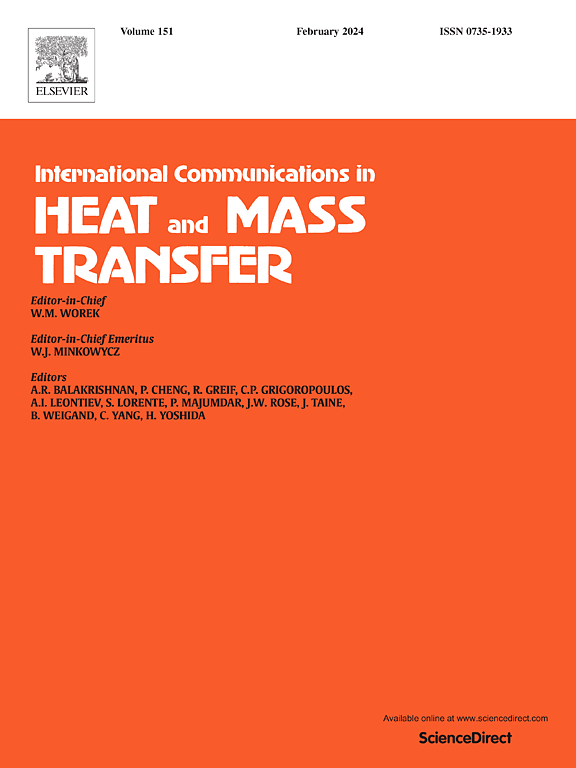重力变化下具有一般流体动力边界的流体层热不稳定性的线性和非线性研究
IF 6.4
2区 工程技术
Q1 MECHANICS
International Communications in Heat and Mass Transfer
Pub Date : 2025-05-17
DOI:10.1016/j.icheatmasstransfer.2025.109016
引用次数: 0
摘要
本研究探讨了重力变化对从下方加热并被困在导热、一般流体力学边界(可渗透)之间的水平液体层热不稳定性的影响。采用线性和非线性两种分析方法来检验系统的不稳定性和稳定性。比较了线性和非线性方法的数值结果,确定了亚临界区域。钱德拉塞卡的方法被用来检验不同物理参数对系统稳定性的影响。在一般水动力边界上验证了稳定性交换原理,并在数值上表明,当重力向上减小时,稳定性交换原理被打破。综合参数分析表明,随着重力和渗透率参数的增大,临界瑞利数开始升高,具有稳定作用。此外,还绘制了描述重力与渗透率相互作用的稳定性曲线。然而,对于足够大的重力值,重力反转改变了稳定条件,导致另一种不稳定机制的出现。这种转变标志着系统行为的根本转变,并强调了极端重力变化下传统稳定性分析的局限性。这些发现为对流动力学提供了新的见解,并有助于更广泛地理解变重力环境中的稳定性。本文章由计算机程序翻译,如有差异,请以英文原文为准。
Linear and nonlinear study of thermal instability in a fluid layer with general hydrodynamic boundaries under gravity variations
This study investigates the impact of changing gravity on the onset of thermal instability in a horizontal liquid layer heated from below and trapped between thermally conducting, general hydrodynamic boundaries (permeable). Both linear and nonlinear analysis are employed to examine the instability and stability of the system. The numerical results from both linear and nonlinear techniques are compared to determine the subcritical region. Chandrasekhar’s method is utilized to examine the impact of different physical parameters on the system’s stability. The principle of exchange of stabilities (PES) is verified for general hydrodynamic boundaries and is numerically shown to be violated as gravity decreases upward. A comprehensive parametric analysis reveals that as the gravity and permeability parameters increase, the critical Rayleigh number initially rises, indicating a stabilizing effect. Also, Stability curves depicting the interplay between gravity and permeability are presented graphically. However, for sufficiently large gravity values, gravity reversal alters the stability conditions, leading to the emergence of an alternative instability mechanism. This transition marks a fundamental shift in system behavior and underscores the limitations of traditional stability analysis under extreme gravity variations. These findings offer novel insights into convection dynamics and contribute to the broader understanding of stability in variable-gravity environments.
求助全文
通过发布文献求助,成功后即可免费获取论文全文。
去求助
来源期刊
CiteScore
11.00
自引率
10.00%
发文量
648
审稿时长
32 days
期刊介绍:
International Communications in Heat and Mass Transfer serves as a world forum for the rapid dissemination of new ideas, new measurement techniques, preliminary findings of ongoing investigations, discussions, and criticisms in the field of heat and mass transfer. Two types of manuscript will be considered for publication: communications (short reports of new work or discussions of work which has already been published) and summaries (abstracts of reports, theses or manuscripts which are too long for publication in full). Together with its companion publication, International Journal of Heat and Mass Transfer, with which it shares the same Board of Editors, this journal is read by research workers and engineers throughout the world.

 求助内容:
求助内容: 应助结果提醒方式:
应助结果提醒方式:


